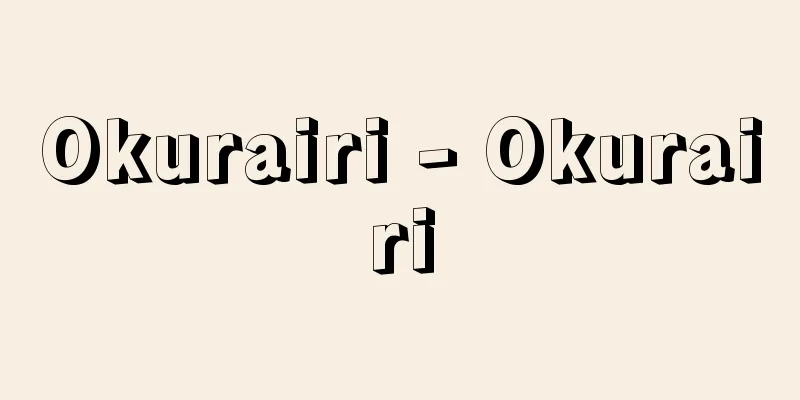Robe - Houe

|
Abbreviation of Nyoho clothing. Also called Hofu, Sofuku, Sogyo, and Koromo, it refers to the clothing worn by monks and nuns. In India, it refers to the three robes of Sogyarie (made of cloth with 9-25 articles), Uttara Soe (7 articles), and Anda-e (5 articles), and is also called Ho-i (four-robe) because of its square shape. In Japanese Zen Buddhism, only Sogyarie is called Ho-i. Broadly speaking, everything worn by monks, such as the Henzan (partial robe) that covers the upper body, the Kunzu (skirt) worn below the waist, and the Jikitotsu (sleeve) that combines the top and bottom, was called Ho-i as it was considered clothing according to the Buddhist law. Therefore, in later generations, it has changed considerably from the Kesa (robes) worn by Indian Buddhist sects, and has come to include a broader meaning. [Kawaguchi Takakaze] IndiaThe clothes of the common people in India were white robes that were not cut into small pieces, but because it was a tropical region, light colors were valued and they were only used to cover the body rather than to protect against the cold. In contrast, Buddhist monks established three robes of muddy colors to emphasize their uniqueness, in order to eliminate craving, which is the root of desire. In other words, since a single piece of cloth would give rise to desire, it was cut into small pieces and a long piece of cloth was joined to a short piece to make one strip, and five strips joined together (10 pieces of cloth sewn together) were called Anda-e. This was worn when doing miscellaneous activities such as cleaning in the temple, and was worn most closely. Next, seven strips joined together (21 pieces of cloth sewn together) were called Uttara monk's robes, and were worn when reciting sutras or listening to lectures. The Sangha robe (9-25 pieces) was made by cutting the cloth into smaller pieces, of which 9-13 were divided into two long pieces and one short piece, 15-19 into three long pieces and one short piece, and 21-25 into four long pieces and one short piece. Therefore, 125 pieces of cloth were needed to make a 25-piece robe. The Sangha robe was worn when entering the royal palace or villages to beg for food. The original intention was to avoid clothing and possessions used by laypeople, but cotton, silk, linen, wool, and other readily available materials were acceptable, and anything that laypeople had discarded in the dung heap was acceptable. Donations from laypeople were also acceptable. In addition to the three robes, there was also a Sangha robe that covered the right shoulder and a skirt that covered the lower half of the body, and together with the three robes, they were called the five robes of a monk or a nun. [Kawaguchi Takakaze] ChinaWhen Buddhism spread to China, the Indian three robes alone were not enough to withstand the cold, so monks began to wear clothes similar to those worn by ordinary people and then put on the Buddhist three robes over them. In other words, the three robes no longer meant clothing, but simply indicated that the person was a Buddhist monk. As a result, the robes and the three robes were differentiated, and the robes became robes that were modified from hengyang and sashes, and the three robes came to be called kesa. For example, the Anda-e was modified into a small, simplified rakusu, and a separate robe called nakottotsu was created as a robe. The Buddhist robes with their irregular colors were called ritsue, and a system was created in which gorgeous robes that incorporated the five standard colors from the imperial court were given as shie. Furthermore, a debate arose between Dosen and Gijo over clothing and accessories, who forbade silk and insisted that cotton fabrics be used instead. The hooks and ties that were originally meant to prevent the robes from falling to the ground in the wind were also decoratively beautified, and eventually evolved to include accessories made of ivory or gold rings. [Kawaguchi Takakaze] JapanWhen Buddhism was introduced to Japan, it was mainly accepted by the Imperial family, and monks (soryo) became people regulated by the state, and their robes were regulated according to the attire of aristocrats closely related to the Imperial family. As a result, the official uniforms and secular clothing of aristocrats were repurposed for monks' robes, and furthermore, as Buddhist sects were born, the appearance of robes also differed depending on the sect. Broadly speaking, they can be classified into three types: (1) those used by Tendai, Shingon, Jodo, Jodoshin, and Nichiren sects are called kyoi (religious vestments), (2) Zen robes that are centered on a nakomata and tsurako (traditional Japanese robe) that hang from both shoulders to the chest, and (3) the ristocratic robes of the Ritsu sect, which wear three robes centered on a hen'en and a shiko (shoulder skirt), but do not use purple or scarlet robes. In this way, when the three robes, which were originally made by picking up discarded cloth from laypeople, cutting it up, sewing it together, and giving it a discolored color, were introduced to China and Japan, due to differences in climate and customs, various types of robes, including underwear worn underneath the three robes, official uniforms, and secular clothing, came to be called "koromo" to distinguish them from kesa. For this reason, during the Kamakura period, Dogen wrote two volumes of "Shobogenzo," "The Merits of the Kesa" and "Den'i," in which he preached about the kesa of the orthodox Buddhism. In the Edo period, each sect emphasized the observance of the precepts, and a restoration movement to return to the orthodox Buddhist kesa developed. Many books on the study of kesa were written by Hotan, Kokoku, Onko, Tainin, Sodo, Menzan, Mokushitsu, Raizen and others who investigated Buddhist robes. [Kawaguchi Takakaze] "History of Legal Robes" by Masakaze Izutsu (1974, Yuzankaku Publishing) " A Study of Legal Robe Standards" by Kofu Kawaguchi (1976, Daiichi Shobo) [Reference] |The painting depicts a monk wearing a monk's collar (a style of collar with a wide collar that stands up), which was used in Japan from the mid-Heian period onwards. Priest's robes as seen in the Shigisan Engi Emaki ©Shogakukan "> Robes Source: Shogakukan Encyclopedia Nipponica About Encyclopedia Nipponica Information | Legend |
|
如法(にょほう)の衣服の略称。法服、僧服、僧衣、衣(ころも)ともいい、僧尼が着ける衣服のこと。インドにおける意味は、僧伽梨衣(そうぎゃりえ)(9~25条の布で製したもの)、鬱多羅僧衣(うったらそうえ)(7条)、安陀会(あんだえ)(5条)の三衣(さんえ)をさし、四角の衣服の意味から「方衣」ともいう。日本の禅宗では、三衣のなかの僧伽梨衣だけを法衣という。広くは上半身を覆う偏衫(へんざん)、腰より下をまとう裙子(くんず)、上下を一つにした直裰(じきとつ)など、僧の身に着けるものすべてを仏法の衣服として法衣と称した。したがって、後世にはインドの仏教教団で着用した袈裟(けさ)から、かなり変遷しており、広い意味まで含むようになった。 [川口高風] インドインドの俗人の衣服は、衣財(えざい)を細かく割截(かっせつ)しない白衣であったが、それは熱帯地であるため、色彩も淡泊なものを尊び、寒冷を防ぐというよりも身体を覆うだけのものであった。それに対し、仏教の出家者は壊色(えじき)(濁った色)の三衣(さんえ)を制定し特異性を強調したが、それは欲望の根源である渇愛(かつあい)を打ち消すためであった。つまり、割截しない一枚の布では、欲望がおこるため、それを小さく切り、一枚の長い布と短い布をつなぎ合わせて1条とし、5条つないだもの(布を10枚縫い合わせる)を安陀会といった。これは、寺内で掃除など雑行のときに着用し、もっとも身近に着けた。次に、7条つないだもの(布を21枚縫い合わせる)を鬱多羅僧衣といい、誦経(じゅきょう)したり講義を聞くときに着けた。僧伽梨衣(9~25条)は、さらに細かく布を割截したもので、そのうち9~13条は長い布を二枚、短い布を一枚、15~19条は三長一短、21~25条は四長一短に区画した。そのため、25条衣は125枚の割截した布が必要である。なお、僧伽梨衣は王宮や集落に入って乞食(こつじき)説法するときに着けた。衣財は、在家者の用いるものを避けるのが本意であるが、綿布、絹、麻、羊毛など身近に手に入るものでよく、在家者が不用で糞塵(ふんじん)に捨てたものならなんでもよかった。また、在家者から施されたものもよい。そして、三衣のほかに右肩を覆う僧祇支(そうぎし)と、下半身を覆う裙子もあって、三衣と合わせて、比丘(びく)、比丘尼の五衣(ごえ)といった。 [川口高風] 中国仏教が中国に伝播(でんぱ)すると、インドの三衣だけでは、寒冷に耐えうることができないため、出家者も一般人の衣服に類したものを被着し、その上に仏制の三衣を着けるようになった。すなわち三衣は、衣服の意味でなく、ただ仏教の出家者を表示するだけとなった。そのため衣服と三衣とが区別せられ、衣服は偏衫や裙子の変型してできた法衣となり、三衣は袈裟とよばれるようになった。たとえば、安陀会は小さな略式の絡子(らくす)と変型し、法衣として、別に直とつが生まれた。また仏制による壊色の袈裟は律衣(りつえ)とよばれ、朝廷から五正色(せいじき)を取り入れた華麗な袈裟は、賜衣(しえ)とする制度も生まれた。さらに、衣財も絹を禁じ、綿布を用いなければならないという道宣(どうせん)、義浄(ぎじょう)の衣財論争も生じた。そして、本来、袈裟が風によって地に落ちるのを防ぐための鉤紐(こうちゅう)も装飾的に美化され、象牙(ぞうげ)や金環の付属品をつけるまでに発展した。 [川口高風] 日本仏教が日本に伝来すると、皇室を中心に受容され、僧侶(そうりょ)も国家の規定による人となり、法服も皇室に関係深い貴族の服装に準じて規定された。したがって、貴族の官服や俗服が僧侶の法服に転用され、さらに、仏教の宗派が生まれるや、法衣の様相も宗派によって異なりをみせた。大きく分けると、〔1〕天台、真言、浄土、浄土真、日蓮(にちれん)宗などに用いられるものを教衣といい、〔2〕直裰を中心に絡子を両肩から胸間に垂らす禅衣、〔3〕偏衫や裙子を中心に、紫衣や緋衣(ひえ)は用いないが、三衣を着用する律宗の律衣の3種に分類することができる。 このように、元来は、俗人が捨てた布を拾い、截断して縫い合わせ、壊色にした三衣が中国や日本に伝来すると、気候、風土の異なりから、三衣の下に着ける下着や官服、俗服などまでが種々の法衣となり、「ころも」と称して袈裟と区別するようになった。そのため、鎌倉時代には、道元(どうげん)が『正法眼蔵(しょうぼうげんぞう)』「袈裟功徳(けさくどく)」「伝衣」の二巻を著し、正伝の仏法の袈裟を説いたのをはじめ、江戸時代になると、各宗派で戒律遵守(じゅんしゅ)が強調され、正伝の仏袈裟に帰るべき復古運動が展開されて、鳳潭(ほうたん)、光国、飲光(おんこう)、諦忍(たいにん)、祖道、面山、黙室、来禅らによって、多くの袈裟研究書が著され、仏法衣を追究した。 [川口高風] 『井筒雅風著『法衣史』(1974・雄山閣出版)』▽『川口高風著『法服格正の研究』(1976・第一書房)』 [参照項目] |日本で平安時代中期以降に用いられた僧綱襟(広幅の襟を立てる形式)を着用する僧侶が描かれている。『信貴山縁起絵巻』(部分) 写国立国会図書館所蔵"> 『信貴山縁起絵巻』にみる法衣 ©Shogakukan"> 法衣 出典 小学館 日本大百科全書(ニッポニカ)日本大百科全書(ニッポニカ)について 情報 | 凡例 |
<<: Defense-related expenditures
Recommend
Fukutaro Okui
1897-1965 A sociologist from the Showa era. Born ...
Even balance
A balance with a pan on each end of a beam. It is ...
Song mantra - Utano Makoto
...In the field of art, Basho's theory of &qu...
Religious studies - history of religions
A general term for academic studies that study re...
Zvartnots
...However, in the vicinity of the town, there re...
Buchenwald (English spelling)
One of the concentration camps established by the ...
Chen Yi
Chinese politician and soldier. Born in Sichuan P...
Koshiki (English: Gu-shi-ji)
A collection of classical Chinese poetry. Compiled...
Bharata (personal name) (English spelling) Bharata
…A treatise on the theatre of Indian classical dr...
Takaragawa [Hot Spring] - Takaragawa
A hot spring located in Minakami-machi, Gunma Pref...
Kyosai
...Grape and peach cultivation began in earnest i...
Villa dei Misteri (English spelling)
...The conditions for the establishment of this n...
Acute unexpected death - Kyuseifusoukushi
…Sudden deaths in infants can be broadly divided ...
Parkinson's Law
A general term for irrational practices in the or...
Artesian
…The water level of artesian groundwater is usual...









